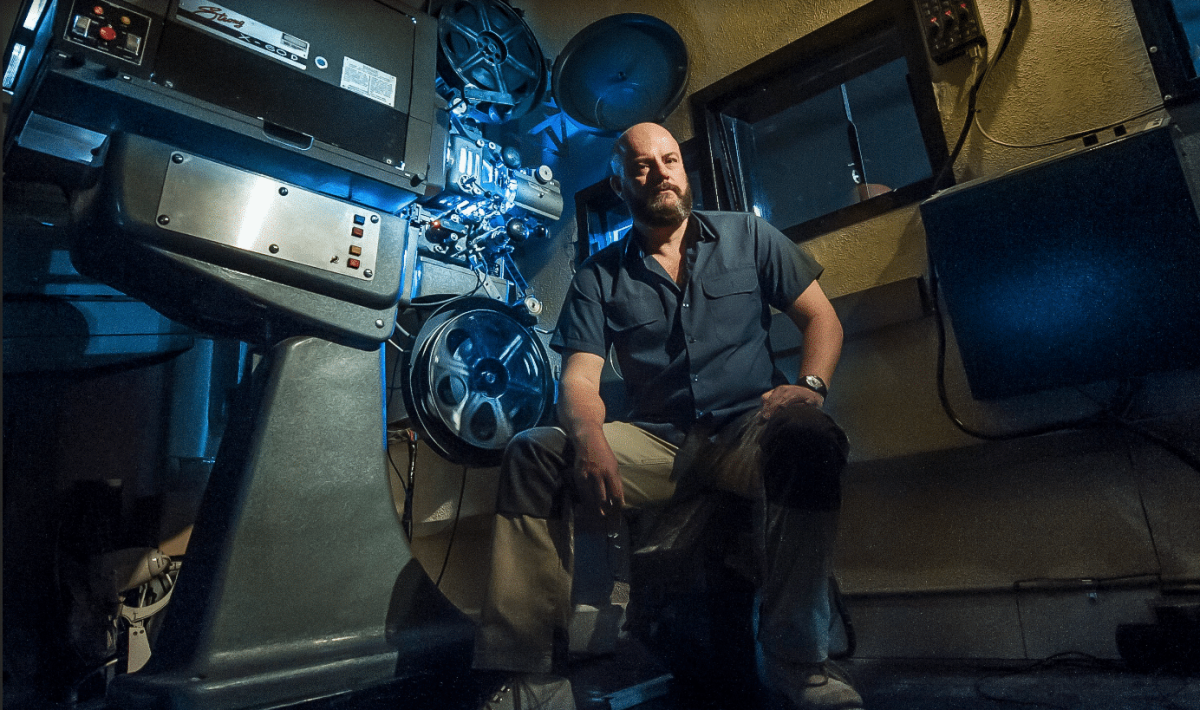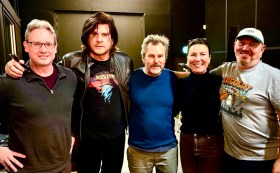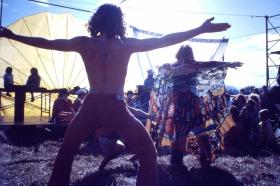Cinephiles, rejoice! We have a documentary that finally sets straight the decades-old argument of digital vs film … well, sort of.
As film director and long-time projectionist of Melbourne’s The Sun theatre Rob Murphy explains, the look of film is ultimately ‘always better,’ and has been ‘natively 4k’ for years – but due to unavoidable setbacks such as vinegar syndrome (where film reels quite literally go off and lose all colour), it’s not sustainable.
‘Nitrate was the norm prior to the 50s, but that turned out to be explosive … then acetate took over and it would decay. Now we’re on polyester film, which they say will last 300 years … but in 30 years’ time we might discover an issue with that too. So who knows?’
Despite the uncertainty, Murphy is still a staunch advocate for film projection, and his documentary Splice Here: A Projected Odyssey is a love letter to this process. We sat down with him to chat about the doco that was some 10 years in the making, and how he envisions the future of cinema projection.
Overture
Murphy begins his journey with a question: what happened to cinema’s first, great (now long extinct) wide-screen film process, Cinerama? Cinerama was once the ultimate way to watch movies: on a large, curved screen where three separate projectors combined individual sides of the image to create a dizzying, almost 3D effect. ‘I had no idea it could look like that,’ he said.
When the shift to digital happened, it was all but lost. In fact, it had already gone out of fashion well before that, meaning that Murphy had never had a chance to see a film in that format.
From that kickoff point, Rob Murphy’s quest expands thematically and geographically. ‘At first, it was really just a knee-jerk reaction to what was happening in the industry at the time.’
Then he realised that ‘this first decade of digital projection has been such a tumultuous time in the history of cinema. So much has happened in this first decade.’ That thought took him all over the world via a secret society known as the ‘projectionist underground’, a group of projection workers who champion the old ways of film.
Given that Murphy himself is a projectionist, he always had an ‘in’ to this secret society, but the excuse of the documentary gave him an extra edge, which led to him meeting one of his heroes: Douglas Trumbull, the (now deceased) American film director and innovative visual effects supervisor who worked on classics like 2001: A Space Odyssey and Close Encounters of the Third Kind.
‘That was an amazing day,’ he said, beaming. ‘We went back to his office and we spoke all afternoon. He was such a kind and supportive person.’
After that fateful conversation, Trumbull became one of Splice Here‘s biggest advocates. ‘He was writing letters to the studios to help us drop the cost of rights on certain things we needed to use,’ Murphy said. ‘And he was able to see one of the cuts of this film before he passed away, which I will always treasure’.
Meanwhile, the film was growing into quite the epic: Murphy was shooting sequences of himself looking at dusty warehouse archives, Indiana Jones style, for any trace of old Cinerama projectors or ‘lost’ film reels. ‘I made sure to pepper in lots of film gags for the cinephiles,’ he said. ‘Including using the opening title music for Silent Running when I’m on my way to Douglas Trumbull’s place.’
Intermission
Then, in 2015, rumblings of a ‘return to film’ began spreading their way throughout the world. Quentin Tarantino, master of the vintage homage, had announced that his latest film The Hateful Eight would be presented on 70mm film wherever possible. It was shot on Ultra Panavision (allowing for 2.76:1 aspect ratio), which meant that a 70mm projection was the ‘ultimate way to see it’.
But Rob Murphy didn’t have a 70mm projector at The Sun – yet. Suddenly, the focus of Splice Here was pivoting once again: could Murphy and his team source the parts for, build, and run a 70mm projector in time for The Hateful Eight‘s release?
If you were following The Sun theatre’s social media at the time – or, in fact, any of Australia’s mainstream news channels – then you may already know the answer. Quentin Tarantino himself came to Yarraville just to see what Murphy had achieved.
‘He came up to my projection booth and I had about 15 minutes alone with him to chat,’ he said. ‘And I actually thought, “Oh, what am I going to say?” But, you know, you put two film nerds together and we can’t shut up. It was incredible.’
‘The whole thing was pretty much out of the blue,’ Murphy added. It needs to be seen to be believed.
Epilogue
Murphy told me that he’s hopeful film projection will continue as long as it can, and where it’s appropriate.
‘Christopher Nolan’s next film will be released in 70mm next year, and I really hope our cinema gets a print,’ he said. ‘It has a natural resolution of around 9k, which people don’t really understand, but it’s just beautiful. Digital can’t really do that resolution justice.’
‘It’s not that digital is the replacement for film, it’s that we simply have another new medium to work with. But film is a unique experience, and I want to preserve that for future generations. The digital revolution does threaten that somewhat, even though without it some restorations and preservations wouldn’t be possible.’
As for what will happen to this documentary, Murphy is fine with it being presented digitally. ‘It’s such a behemoth, and there’s so much footage we haven’t used that could end up being a miniseries,’ he said. I for one really hope that happens, as there’s so much to be learned about film history here.
And what of Cinerama? We won’t spoil the answer of what became of it for you, but let’s just say Splice Here has a wonderful payoff that you’ll want to see.
Splice Here: A Projected Odyssey is playing at various cinemas around Australia. Rob Murphy will be present for Q&A’s in the following cinemas:
- New Farm Cinema, Brisbane. Nov 27 2022
- The Ritz, Randwick. Nov 29 2022
- Hayden Orpheum, Cremorne. Nov 30 2022
- Classic Cinemas, Elsternwick. Dec 1 2022
- Lido Cinemas, Hawthorn. Dec 3 2022
- Cinema Nova, Carlton. Dec 4 2022
- The Pivotonian, Geelong. Dec 7 2022
- The Astor Theatre, St Kilda. Dec 11 2022
For tickets and more information, head to the Splice Here website.





